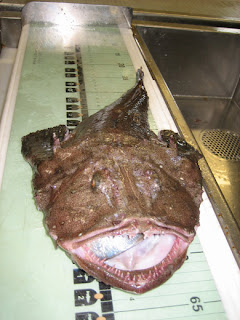Goosefish capture small puffins over deep water of Northwest Atlantic
A recent study has shown that bottom-dwelling goosefish, also known as monkfish, prey on dovekies, a small Arctic seabird and the smallest member of the puffin family. To understand how this deep-water fish finds a shallow-feeding bird in offshore waters, researchers looked at when, where, and how these animals were most likely to be in the same place at the same time. Remains of fourteen dovekie were recovered from the stomachs of 14 goosefish caught during the winters between 2007 and 2010. The goosefish were captured in gillnets deployed at depths between 275 and 495 feet in waters 65 to 95 miles south of Chatham, Mass. The Cape Cod Commercial Hook Fishermen's Association collected the specimens and provided them for the research study.
Researchers from NOAA's Northeast Fisheries Science Center (NEFSC) in Woods Hole, Mass. and the USGS Patuxent Wildlife Research Center in Laurel, Md., wanted to know how the birds could be captured so far from shore by a fish that lives on the ocean bottom in deep water. Their findings, recently published online in the Northeastern Naturalist, suggest that it is all a matter of timing.
Goosefish (Lophius americanus) are highly opportunistic predators. Distributed from the Gulf of Maine to Cape Hatteras, N.C., the fish are typically partially buried on soft bottom habitats and attract a variety of prey by using a modified dorsal fin ray that resembles a fishing pole and lure.
Dovekies, a small black and white puffin species, breed along the Arctic coast and head south in the winter, typically as far as New England. The dovekie (Alle alle), also known as little auk, is the smallest of the auks. It lives in the open ocean and can dive to depths o more than 100 feet to prey on small fish, crustaceans, and zooplankton.
Study co-author Anne Richards of the NEFSC says tagging studies that she and colleagues have conducted reveal that goosefish swim considerable vertical distances from the bottom to near the surface, especially during their spring and fall migrations onshore and offshore in response to water temperatures and related factors.
Goosefish leave the bottom to use the currents during migration periods or to spawn at the surface. If prey items are encountered during their vertical movements, the goosefish take advantage. Hence, timing may be the key factor in bringing dovekies and goosefish together in the same place.
"Given the common name 'goosefish', it is not surprising to find birds in goosefish stomachs, but it is surprising to find that this predation occurs over deep water, "Richards said. "Goosefish do not actively seek out the dovekies, but when such tasty morsels are available in the water column, the fish are going to consume them."
 |
| A goosefish or monkfish (Lophius americanus) is measured at sea. Credit: NOAA |
Another source of data used in the study is the NOAA NEFSC food-habits database, which contains decades of predation information collected from the stomachs of fish that are caught during regular research vessel surveys. While not a particularly good measure of how often or how many birds are eaten by fish, these data confirm that not only goosefish, but also spiny dogfish, Atlantic herring, pollock, Atlantic cod, red hake, and fourspot flounder will eat birds.
Lead author Matthew Perry, a research wildlife biologist at the USGS Patuxtent Wildlife Research Center, says he became interested in goosefish predation when he learned from a sea scalloper on Nantucket that Chatham gillnetters were finding birds inside goosefish stomachs.
"I was studying long-tailed ducks and thought, to avoid being eaten, these birds fly 30 to 50 miles to Nantucket Sound each night and return to the ocean in the morning," said Perry, who studies several species of seaducks. "People ask why don't dovekies fly to Nantucket Sound at night like the long-tailed ducks to avoid goosefish? My explanation is that dovekies have small wings and can't make the routine flight."
"One thing we know is that dovekies cannot dive to the bottom in 300 to 400 feet of water," Perry said. "Goosefish probably come up from the ocean bottom to within 10 to 20 feet of the water surface at night. As dovekies dive for amphipods, small crustaceans, in the morning at first light, goosefish seize the opportunity and might use their 'fishing lure' to simulate one of these prey species by attracting the dovekies with their typical 'sit and wait' behavior."
The magnitude of fish predation on seabirds is poorly understood. Perry says most food habit studies for goosefish have been conducted during summer when the dovekies have migrated north to their Arctic breeding areas; thus, they seldom have been recorded as prey. Perry hopes more telemetry tracking of goosefish will be done in winter when birds are in the area and are potential prey.
As for what's ahead, Richards says ongoing use of electronic tags on goosefish will provide more information on their vertical movements.






